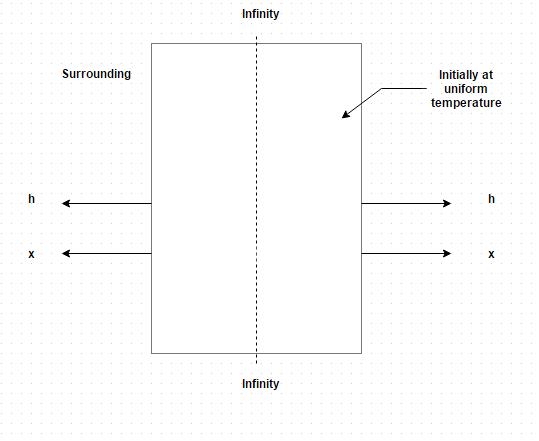This set of Heat Transfer Multiple Choice Questions & Answers focuses on “Transient Heat Conduction In Solids With Finite Conduction”.
1. Diagram shows transient heat conduction in an infinite plane wall. Identify the correct boundary condition in transient heat conduction in solids with finite conduction

a) t = t i at T = 0
b) d t /d x = 1 at x = 0
c) d t /d x = infinity at x = 1
d) d t / d x = infinity at x = 0
View Answer
Explanation: d t / d x = 0 at x = 0. The solution of controlling differential equation in conjunction with initial boundary conditions would give an expression for temperature variation both with time and position.
2. Let there is some conduction resistance, then temperature becomes a function of
(i) Biot number
(ii)Fourier number
(iii) Dimensionless parameter
a) i and ii
b) ii and iii
c) i and iii
d) i, ii and iii
View Answer
Explanation: It should be the function of all of the above i.e. Biot number, Fourier number and dimensionless parameters which includes all the dimensionless numbers.
3. The value of Biot number and Fourier number, as used in the Heisler charts, are evacuated on the basis of a characteristics parameter s which is the thickness in case of plates and the surface radius in case of cylinders and spheres.
a) True
b) False
View Answer
Explanation: It must be semi thickness instead of thickness.
4. A large steel plate 50 mm thick is initially at a uniform temperature of 425 degree Celsius. It is suddenly exposed on both sides to an environment with convective coefficient 285 W/m2 K and temperature 65 degree Celsius. Determine the center line temperature.
For steel, thermal conductivity = 42.5 W/m K and thermal diffusivity = 0.043 m2/hr
a) 261 degree Celsius
b) 271 degree Celsius
c) 281 degree Celsius
d) 291 degree Celsius
View Answer
Explanation: t 0 – t a/t I – t a = 0.6.
5. With respect to above problem, determine the temperature inside the plate 12.5 mm from the mid plane after 3 minutes
a) 272.36 degree Celsius
b) 262.36 degree Celsius
c) 252.36 degree Celsius
d) 22.35 degree Celsius
View Answer
Explanation: x/l = 0.5 and t 0 – t a/t I – t a = 0.96.
6. When Biot number exceeds 0.1 but is less than 100, use is made of Heislers charts for the solution of transient heat conduction.
a) True
b) False
View Answer
Explanation: The Heisler charts are extensively used to determine the temperature distribution and heat flow rate when both conduction and convection resistance are of equal importance.
7. In transient heat conduction, the two significant dimensionless parameters are
a) Reynolds number and Fourier number
b) Reynolds number and Biot number
c) Reynolds number and Prandtl number
d) Biot number and Fourier number
View Answer
Explanation: These two are dimensionless numbers. Biot number is given by the ratio of internal conduction resistance to the surface convection resistance whereas Fourier number signifies the degree of penetration of heating or cooling effect through a solid.
8. A 12 cm diameter cylindrical bar, initially at a uniform temperature of 40 degree Celsius, is placed in a medium at 650 degree Celsius with convective coefficient of 22 W/m2 K. Determine the time required for the center to reach 255 degree Celsius. For the material of the bar:
Thermal conductivity = 20 W/m K
Density = 580 kg/m3
Specific heat = 1050 J/kg K
a) 1234.5 seconds
b) 1973.16 seconds
c) 3487.3 seconds
d) 2896.4 seconds
View Answer
Explanation: 1/B I = k/h R = 0.1515, t – t a/t I – t a = 0.647. X / l = 0 (center of the bar). Therefore, α T/R2 = 0.18.
9. Consider the above problem, calculate the temperature of the surface at this instant
a) 476.4 degree Celsius
b) 453.5 degree Celsius
c) 578.9 degree Celsius
d) 548.6 degree Celsius
View Answer
Explanation: r/R = 1 and 1/B I = 0.1515. t 0 – t a/t I – t a = 0.18.
10. A solid which extend itself infinitely in all directions of space is termed as finite solid.
a) True
b) False
View Answer
Explanation: It is known as infinite solid. This type of solid can extend itself in x-direction, y-direction and z-direction.
Sanfoundry Global Education & Learning Series – Heat Transfer.
To practice multiple choice questions in all areas of Heat Transfer, here is complete set of 1000+ Multiple Choice Questions and Answers.
If you find a mistake in question / option / answer, kindly take a screenshot and email to [email protected]
- Practice Chemical Engineering MCQs
- Apply for Mechanical Engineering Internship
- Check Mechanical Engineering Books
- Check Chemical Engineering Books
- Apply for Chemical Engineering Internship
